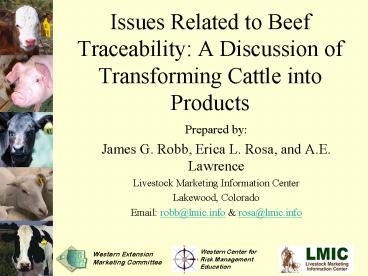Issues Related to Beef Traceability: A Discussion of Transforming Cattle into Products - PowerPoint PPT Presentation
1 / 13
Title:
Issues Related to Beef Traceability: A Discussion of Transforming Cattle into Products
Description:
Issues Related to Beef Traceability: A Discussion of Transforming Cattle into Products Prepared by: James G. Robb, Erica L. Rosa, and A.E. Lawrence – PowerPoint PPT presentation
Number of Views:125
Avg rating:3.0/5.0
Title: Issues Related to Beef Traceability: A Discussion of Transforming Cattle into Products
1
Issues Related to Beef Traceability A Discussion
of Transforming Cattle into Products
- Prepared by
- James G. Robb, Erica L. Rosa, and A.E. Lawrence
- Livestock Marketing Information Center
- Lakewood, Colorado
- Email robb_at_lmic.info rosa_at_lmic.info
Western Center for Risk Management Education
Western Extension Marketing Committee
2
The Industry Has Changed
- Not A Carcass Based Industry
- U.S. Packing Plants are
- High capacity/volume
- Transport products long distances
- Low cost/high volume business
- Relatively concentrated (firms and geography)
- Produces high quality safe products
3
The Production Process
- Disassembly Process
- Beef carcass transformed into boxes of cuts
- Four Major Stages are
- Slaughter or harvest
- Cooler
- Fabrication
- Holding cooler and shipping
4
Stage 1
Packer Operations
Slaughter or Harvest
Animal processed into carcass hides removed,
etc.
Feedlot
Cattle are sorted according to various
specifications i.e. breed, degree of finish, live
weight
5
Stage 2
Carcasses are sorted and assigned into batches
Cooler
6
Stage 3
Batches are broken down into primals, sub-primals
and cuts products are boxed
Fabrication Floor
7
Stage 4
Boxes are sorted then stored or transported by
refrigerated truck
Holding Cooler And Shipping
8
Stage 4 (continued)
Holding Cooler And Shipping
Retailer and/or Foodservice
9
Traceability Challenge
- Forward and Backward Traceability and
Identification Possible - Animal/Carcass
- Specialized (non-commodity) programs
- Electronic systems
- Box of beef cuts
- Normal production
- Food safety recall purposes, i.e. E. coli O157H7
10
Traceability Challenge
- Group (lot) Traceability vs. Individual Animal ID
- BSE requirements, i.e. BEV, SRMs
- Understanding the Fabrication Stage
- Not a linear process
- Becomes a function of time or batch
- Animal ID disconnection
- Beef trimmings
11
Traceability Challenge
- NAIS is Live Animal Traceback
- Beyond live animal or whole carcass ID is not
discussed or required - Linear Traceability
- Disconnection between carcass and beef products
- New ID methods are costly, complicated and not
full proof - Trolley Tracking System, DNA testing
12
Further Challenges
- Byproducts/Offal
- Segregated prior to carcass id
- Other items (fat, bones) commingled during
process - Traceability to end product practically
impossible - Ground Beef/Hamburger
- Batch several combos of trimmings
13
Summary
- Not A Carcass Based Industry
- Disassembly Process
- Nonlinear Flow at Fabrication
- NAIS is a Live Animal ID System Only
- Existence of Economic Incentives will be a Key to
Implementing Farm-to-Fork Traceability




























![China Beef Cattle Farming Industry and Beef Market 2010-2019 [Market Research Report] PowerPoint PPT Presentation](https://s3.amazonaws.com/images.powershow.com/8317425.th0.jpg?_=201512120511)


